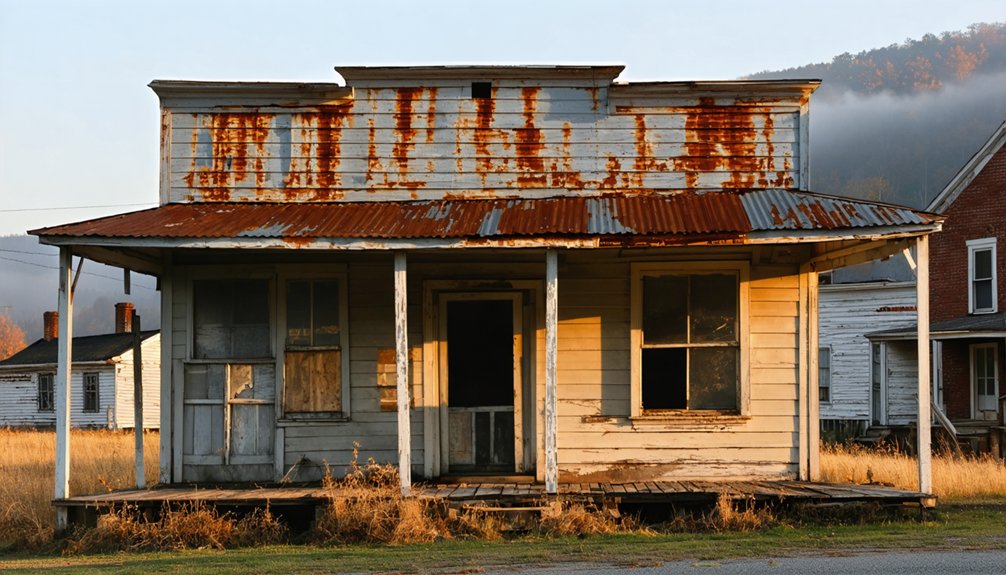You’ll find Jonkan in eastern Kentucky’s Pike County, about 7 miles from Pikeville along Jonican Branch at 879 feet elevation. This former coal mining community thrived in the early-to-mid 1900s, with families living in modest wooden homes while men worked the mines. Today, nature has reclaimed most traces of the town, though its coordinates (37°26′58″N 82°23′32″W) mark where a once-bustling community stood. The story of Jonkan’s rise and fall mirrors countless Appalachian mining towns.
Key Takeaways
- Jonkan is an abandoned coal mining town in Pike County, Kentucky, located 7.2 miles east-southeast of Pikeville at 879 feet elevation.
- The town’s economy centered on coal mining from early 1900s to mid-century, with operations shifting from hand-loading to mechanized extraction.
- Decline began as Kentucky’s coal industry faced challenges, leading to a 60% drop in employment and widespread abandonment.
- Community life featured multi-generational housing, church gatherings, and strong social bonds before the town’s abandonment.
- The ghost town’s physical remains are now largely obscured by nature, though its location is documented at 37°26′58″N 82°23′32″W.
Location and Geographic Setting
Nestled in the rugged terrain of eastern Kentucky’s Pike County, the ghost town of Jonkan sits along Jonican Branch approximately 7.2 miles east-southeast of Pikeville.
Along the winding Jonican Branch in Pike County lies Jonkan, a forgotten ghost town tucked into Kentucky’s rugged eastern hills.
You’ll find this abandoned settlement at an elevation of 879 feet, where it’s surrounded by the distinctive geographic features of the Appalachian Plateau – a landscape dominated by steep hills, deep valleys, and dense hardwood forests.
Due to the lack of documentation, historical details about this settlement remain largely unverified.
The site’s environmental conditions reflect the region’s humid subtropical climate, with warm summers and mild winters shaping the natural surroundings.
While the town itself no longer thrives, you can still locate it within the 41557 ZIP code area, accessible via Jonican Road. The town is also known by its alternate name Jonican among locals.
The nearby branch provides a steady water source, while the untamed wilderness has gradually reclaimed what was once a bustling community.
Origins and Early Settlement
While the exact year of Jonkan’s founding remains unclear, you’ll find its origins rooted in Pike County’s early development during Kentucky’s settlement period.
Early settlers established themselves along Jonican Branch, recognizing the waterway’s crucial importance for sustaining a new community. You’ll discover that the town, also known as Jonican, grew as pioneers utilized local resources for their livelihood. Like many Kentucky settlements, the community thrived until natural resources depleted, forcing residents to seek opportunities elsewhere. Similar to other settlements that became ghost towns, Jonkan experienced a decline as economic opportunities diminished.
Community development centered around Jonican Road, which provided essential access to larger settlements like Pikeville, about 7.2 miles away.
The area’s early inhabitants likely engaged in traditional activities common to Pike County settlements, possibly including farming and resource extraction.
While specific details about the town’s earliest days are scarce, you can trace its establishment through its strategic location along water sources and transportation routes.
Coal Mining Legacy
As you explore Jonkan’s coal mining operations from the early 1900s through mid-century, you’ll find evidence of both underground portals and mountaintop mining sites that once employed thousands using advanced tramways and electric equipment.
The town’s economy centered entirely around coal production, with miners dependent on company scrip for purchases at the central commissary while enduring dangerous working conditions and limited safety protections. Around six to seven cents per ton was the standard pay rate for miners in the early years. The region’s transition to surface mining in the mid-1950s transformed the landscape as companies sought to reduce costs amid changing market demands.
Mining Operations Overview
Since its first commercial ventures in 1820, Kentucky’s coal mining industry transformed the state’s economic landscape through a complex network of operations spanning both Western and Eastern Coalfields.
You’ll find that mining operations evolved from basic hand-loading practices to mechanized extraction after World War II, dramatically increasing production efficiency.
Throughout Kentucky’s coalfields, companies like Blue Diamond near Hazard and the Consolidation Coal Company in Pike County built extensive community infrastructure, including worker housing, schools, and company stores. By 1918, the U.S. Steel operations were shipping approximately 12,000 tons of coal daily to mills in Gary, Indiana.
While these operations brought economic prosperity, they weren’t without their dark side – mining accidents and environmental concerns plagued the industry. The first organized coal extraction began at the McLean drift bank, marking the start of Kentucky’s rich mining heritage.
The introduction of railroad networks proved essential, connecting mining operations to urban markets and enabling Kentucky’s coal production to surge from 100,000 tons in 1843 to over one million tons by 1879.
Economic Collapse Impact
Once Kentucky’s coal industry dominated the state’s economy, generating $10 billion in output and supporting over 42,000 jobs at its peak in 2010.
But you’ll find a very different reality in Jonkan today. The economic implications of coal’s decline have been devastating – employment plummeted by 60% from its heights, leaving fewer than 20,000 jobs by 2010.
Community resilience has been severely tested as mining operations shut down, taking with them the high-wage jobs that once sustained local families. The labor income benefits continue to shrink for local economies and households.
The ripple effects have touched every aspect of life. By 2021, coal’s total economic impact had shrunk to $2.4 billion, supporting just 8,500 jobs statewide.
Tax revenues that once funded regional development have dried up, and the brain drain continues as skilled workers leave in search of opportunities elsewhere.
Daily Life in Historic Jonkan
You’ll find daily life in historic Jonkan revolved around demanding physical labor, with men and older boys working long hours in local mines or forests while women maintained households and tended gardens.
Much like in Paradise, Kentucky, residents watched their community slowly fade as environmental changes transformed the landscape.
Social activities centered on church gatherings, family visits, and community events that strengthened bonds among the isolated settlement’s residents.
Families typically lived in modest wooden homes, often sharing close quarters with multiple generations under one roof, as was common in Appalachian communities of the era.
Work and Labor Patterns
While many aspects of Jonkan’s history remain uncertain, the town’s work patterns followed typical rhythms of Appalachian resource towns in Pike County.
You’d have found most residents engaged in physically demanding extraction work, facing daily labor struggles and minimal work safety protections. The harsh realities of mining and timber operations shaped the community’s routines from sunrise to sunset, six days a week.
If you’d lived in Jonkan during its peak, you would’ve experienced:
- Dangerous working conditions in mines or timber operations, with constant risks of cave-ins and accidents
- Payment often in company scrip, redeemable only at the company store
- Seasonal work fluctuations, with timber cutting in winter and year-round mining dependent on weather and market demands
Community Social Activities
Beyond the daily grind of work, Jonkan’s social fabric wove together through rich community traditions and gatherings. You’d find folks congregating on front porches, sharing stories of local lore while children played marbles and hopscotch nearby.
The church served as the heart of social life, hosting weddings, baptisms, and revival meetings that brought everyone together.
During evenings and weekends, you’d hear the twang of banjos and fiddles as neighbors gathered for square dances. Community gatherings often centered around seasonal events like harvest festivals and Decoration Day.
Social traditions included informal lending networks, where you could count on neighbors for tools or help with chores. Card games, checkers, and dominoes filled leisure hours, while community meals and canning bees strengthened the bonds between families.
Family Housing Arrangements
Three distinct types of housing dotted Jonkan’s landscape during its heyday as a coal mining community. You’d find simple, functional homes that reflected the hardworking spirit of local families, where daily life centered around community support and family dynamics.
Housing conditions were basic, with most homes lacking modern amenities due to the town’s remote location.
- Small, single-family dwellings built close together fostered strong neighborhood connections.
- Family homesteads with space for small gardens and livestock helped supplement household income.
- Multi-generational homes where extended families lived together, sharing resources and responsibilities.
The close-knit housing arrangements meant you’d often find families helping each other with daily tasks, from child-rearing to maintaining their properties, creating a resilient community spirit that defined Jonkan’s character.
Economic Rise and Decline
Although records about Jonkan’s economic history remain sparse, the town’s trajectory followed a pattern common to many rural Kentucky communities of its era. You’ll find that Jonkan’s early economic resilience stemmed from its natural resources and agricultural foundations, with community networks strengthening local trade through small businesses and farming operations.
The town’s rise likely peaked when transportation networks opened new opportunities for commerce, though limited infrastructure posed ongoing challenges. You might’ve seen similar patterns in other Kentucky towns where initial prosperity gave way to decline.
As resources potentially depleted and younger residents sought opportunities elsewhere, Jonkan’s economy couldn’t sustain itself. The absence of industrial diversification and the pull of urban areas ultimately contributed to the town’s abandonment, leaving behind another quiet reminder of Kentucky’s changing rural landscape.
Remaining Physical Traces

Despite extensive research into Kentucky’s ghost towns, Jonkan’s physical remains prove particularly elusive in modern records.
Kentucky’s lost settlement of Jonkan stands as one of the state’s most mysterious ghost towns, its traces vanishing into historical obscurity.
You’ll find that nature has reclaimed much of what once stood here, with vegetation obscuring any physical remnants that might’ve survived the passage of time. The site presents significant exploration challenges due to its abandoned state and absence from current maps.
If you’re planning to visit Jonkan, you’ll want to reflect on:
- Limited infrastructure visibility due to extensive overgrowth
- Difficult access routes as former pathways have deteriorated
- Weather-related obstacles typical of Kentucky’s climate
Like many ghost towns in the region, Jonkan’s physical traces continue to fade with each passing season, though the site maintains potential value for archaeological study and historical research.
Cultural Impact on Pike County
Jonkan’s legacy in Pike County extends well beyond its physical remains, shaping local understanding of Appalachian boom-and-bust cycles.
While you won’t find the town mentioned in tourism brochures or heritage festivals, it’s woven into the region’s cultural identity through oral histories and family stories passed down through generations.
The ghost town serves as a powerful reminder of eastern Kentucky’s economic changes, particularly in communities that once relied on coal and timber.
You’ll find Jonkan’s influence in local folklore and informal discussions about rural depopulation, though it’s overshadowed by more famous Pike County sites tied to the Hatfield-McCoy feud.
Despite minimal documentation in historical archives, the town’s story continues to resonate as a teaching tool about Appalachian resilience and adaptation.
Transportation and Accessibility

While exploring the remnants of Jonkan today, you’ll find the ghost town nestled along Jonican Branch, approximately 7.2 miles east-southeast of Pikeville.
The rugged Appalachian terrain has shaped the accessibility of this historic settlement, with Jonican Road serving as your primary access point. Current road conditions may challenge your journey, as the area’s infrastructure has deteriorated since the town’s abandonment.
To reach this remote ghost town, you’ll need to take into account:
- Bringing a personal vehicle capable of handling unpaved or degraded roads
- Planning your route through nearby towns like Elkhorn City or Coal Run Village
- Being prepared to hike, as some areas may no longer be accessible by vehicle
The site offers no modern amenities or facilities, reflecting its true ghost town nature in Kentucky’s mountainous wilderness.
Notable Local Stories
Although local stories about Jonkan remain largely undocumented in public records, you’ll find the town’s narrative closely mirrors those of other Appalachian mining communities.
Like its neighbors, Jonkan’s history likely includes local legends passed down through generations of mining families who called this small settlement home.
While specific oral histories haven’t been preserved in public archives, you can imagine the stories that once echoed through the hills – tales of mine life, community gatherings, and the close-knit bonds that defined daily existence.
The town’s legacy probably includes accounts of hardship and resilience, typical of coal communities that rose and fell with the industry’s fortunes.
These unrecorded stories remain part of the broader tapestry of Appalachian culture and heritage.
Present-Day Significance

Today, the ghost town of Jonkan stands as a marked point on Pike County maps, located precisely at 37°26′58″N 82°23′32″W, about 7.2 miles east-southeast of Pikeville.
While you won’t find maintained facilities or interpretive signs, its documented location continues to draw interest from those studying Appalachian history and ghost town tourism enthusiasts.
The site’s significance extends beyond its abandoned status:
- It serves as a valuable case study for economic studies focusing on coal town boom-and-bust cycles in Eastern Kentucky.
- You’ll find it referenced in regional ghost town databases, contributing to broader historical documentation.
- The location provides researchers with coordinates for potential archaeological investigations into early 20th-century Appalachian life.
Despite minimal physical remains, Jonkan’s preserved location on maps guarantees its continued role in understanding Kentucky’s industrial heritage.
Frequently Asked Questions
Are There Any Supernatural Legends or Ghost Stories Associated With Jonkan?
You won’t find documented haunted locations or ghost sightings in Jonkan. Despite Kentucky’s rich supernatural folklore, this abandoned coal mining town lacks specific paranormal legends in historical records or local tradition.
Did Any Famous People or Notorious Criminals Ever Live in Jonkan?
You won’t find any famous residents or notorious criminals linked to Jonkan in historical records. The town’s documented history doesn’t mention any notable individuals or significant criminal events.
What Happened to the Cemetery and Burial Grounds of Jonkan Residents?
You won’t find clear records of cemetery preservation or burial ground relocation in Jonkan. Like many abandoned coal towns, the cemetery’s likely been reclaimed by nature, though some gravesites may remain hidden beneath vegetation.
Were There Any Major Disasters or Accidents That Contributed to Jonkan’s Abandonment?
You won’t find evidence of major disasters or mining accidents causing Jonkan’s abandonment. Economic decline in the coal industry appears to have driven people away through gradual job losses and mine closures.
Did Native Americans Have Any Settlements in the Jonkan Area Before Mining?
While Native tribes likely passed through the area following regional settlement patterns, there’s no conclusive archaeological evidence of permanent settlements in Jonkan before mining activities began there.
References
- https://kids.kiddle.co/List_of_ghost_towns_in_Kentucky
- https://en.wikipedia.org/wiki/Jonkan
- https://womiowensboro.com/have-you-ever-visited-these-ghost-towns-in-kentucky-video/
- https://www.onlyinyourstate.com/experiences/kentucky/ghost-town-ky
- https://www.youtube.com/watch?v=D9gOmfCuKLs
- https://wbkr.com/visit-these-20-creepy-kentucky-ghost-towns-for-a-halloween-road-trip/
- https://westernkyhistory.org/exploring-the-forgotten-towns-and-ghost-towns-of-western-kentucky/
- https://en.wikipedia.org/wiki/List_of_ghost_towns_in_Kentucky
- https://www.freakyfoottours.com/us/kentucky/
- https://alchetron.com/Jonkan



